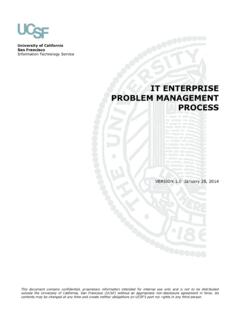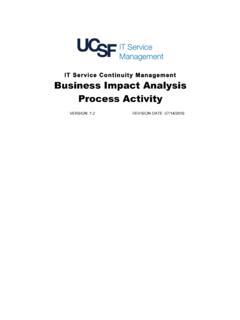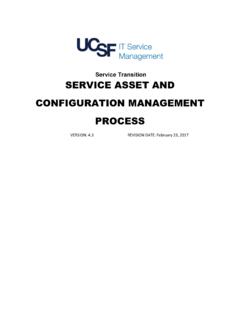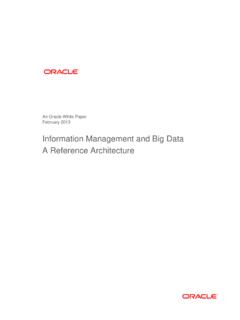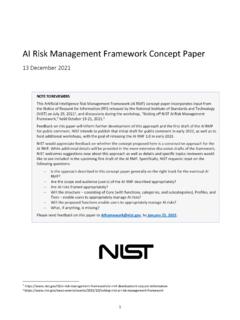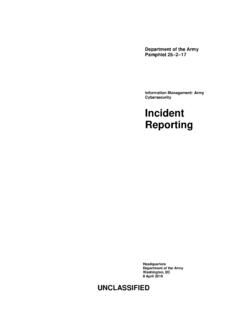Transcription of Service Asset and Configuration Management Process
1 Service Transition Service Asset AND Configuration Management Process VERSION: REVISION DATE: February 23, 2017 Service Transition USER GUIDE Service Asset and Configuration Management Process | 02/23/2017 Page i Contents Section 1. Introduction .. 1 Purpose .. 1 Goal .. 1 Overview .. 1 Key Relationships with other processes .. 2 Definitions .. 2 Section 2. Roles and Responsibilities .. 4 Process Owner/ Configuration Manager .. 4 Configuration Item Class Owner .. 4 Configuration Item Class Administrator .. 4 Configuration Item Company Administrator .. 5 IT Service Continuity Management (ITSCM) 5 IT Staff .. 5 ITSM Product Manager .. 5 Section 3. SACM Process and Relationship Map .. 6 Section 4. Configuration Management Database .. 7 CMDB Content and Structure .. 7 Configuration Item Classes .. 7 Section 5.
2 Network Gear Class Process and Procedures .. 3 Scope .. 3 Network Gear Class Lifecycle .. 3 Network Gear Lifecycle Process .. 4 Network Gear Class RACI Chart .. 4 Network Gear Entry Criteria .. 5 Network Gear Process .. 5 Network Gear Exit Criteria .. 6 Section 6. Server Class Process and Procedures .. 7 Scope .. 7 Server Class Lifecycle .. 7 Server Class Lifecycle Process .. 7 Server Class RACI Chart .. 8 Server Class Entry Criteria .. 8 Server Class Procedures .. 8 Server Class Exit Criteria .. 10 Section 7. Storage Class Process and Procedures .. 11 Scope .. 11 Service Transition USER GUIDE Service Asset and Configuration Management Process | 02/23/2017 Page ii Storage Class Lifecycle .. 11 Storage Class Lifecycle 11 Storage Class RACI .. 12 Storage Class Entry Criteria .. 12 Storage Class Procedures.
3 12 Storage Class Exit Criteria .. 14 Section 8. Application Class Process and Procedures .. 15 Scope .. 15 Definition: Business Service Application - Software .. 15 Application Class Lifecycle .. 16 Application Class Lifecycle Process .. 17 Application Class RACI .. 17 Application Class Entry Criteria .. 18 Application Class Procedures .. 18 Application Class Exit Criteria .. 19 Section 9. Establishing Relationships in the CMDB .. 20 Applications and Server Relationships .. 20 Section 10. SACM CMDB Audit Protocol .. 21 SACM CMDB Audit Purpose .. 21 Background .. 21 SACM CMDB Audit Process .. 21 Section 11. CMDB Structure & Business Service Versus Application .. 22 CMDB Structure Model .. 22 Section 12. Glossary .. 23 Section 13. Revision History .. 24 Section 14. Appendices .. 25 CI Class Owners & Subject Matter Experts.
4 25 SACM CMDB FY16 Goal Milestone Schedule .. 25 Service Transition USER GUIDE Service Asset and Configuration Management Process | 02/23/2017 Page 1 Section 1. Introduction Purpose The purpose of this document is to describe the Service Asset and Configuration Management (SACM) Process . SACM aims to maintain information about Configuration Items (CI) required for the delivery of an IT Service , including their relationships. This document will define the relationship of SACM to other processes, roles and responsibilities of SACM and the Process flow. Goal The goal of the SACM Process is to provide an understanding between incidents and Configuration items. The Configuration Management Database will be the source of truth for Configuration items and their relationship to other Configuration items at UCSF. Overview The Service Asset and Configuration Management Process ensures the integrity of the IT infrastructure by the tracking, recording and reporting on Configuration items.
5 In order to adequately manage and control these CIs, the SACM Process is supported by a Configuration Management Database (CMDB) capable of holding information on all CIs, including attributes and relationships between them. SACM enables IT to achieve control and Management over its IT assets and provides Management information about the IT infrastructure. The Service Asset and Configuration Management Process is divided into five sub-processes: Planning Process Objective: To define the CMDB plan, including purpose, scope, and objectives. Defines Classes, naming conventions, roles and responsibilities, and interfaces with other systems. Identification Process Objective: To define and maintain the underlying structure of the CMDB (the Configuration Model), so that it is able to hold all information on CIs. This includes specifying the attributes describing CI types and their sub-components, as well as determining their interrelationships.
6 Configuration Control Process Objective: To ensure that no CIs are added or modified without the required authorization and those modifications are adequately recorded in the CMDB. Status Accounting Process Objective: To ensure that CI details are updated as the CI goes through the lifecycle. Service Transition USER GUIDE Service Asset and Configuration Management Process | 02/23/2017 Page 2 Verification and Audit Process Objective: To perform regular checks, ensuring that the information contained in the CMDB is an exact representation of the CIs actually installed in the live production environment. Key Relationships with other processes Change Management The Change Management and SACM processes are designed to work together seamlessly in order for the CMDB to accurately reflect the changes that have taken place. Change Management utilizes the information stored in the CMDB for the assessment and authorization of requests for change (RFCs).
7 SACM, by holding information on the relationships between CIs, facilitates this Process for Change Management . Incident Management There is a strong relationship between SACM and Incident Management . Incident Management utilizes information from the CMDB for incident recovery and for informing users on the status of CIs in the infrastructure. The Service Desk can also assist with the validation of the integrity of information in the CMDB due to its function as the central point of contact for users and clients. Incident Management relies on information captured within the CMDB about CIs to perform its activities; it should be able to rely on the SACM Process and the CMDB to provide accurate information . Problem Management Problem Management procedures must ensure that each time a problem or known error occurs and is recorded in the IT Service Management tool, the corresponding Process record is linked to the affected CI in the CMDB.
8 Release Management Release Management is responsible for the Management of the introduction of new CIs to the IT infrastructure. The objective of this Process is to ensure and coordinate the production readiness or supportability and distribution of new elements introduced to the IT infrastructure. The Process accomplishes this in close collaboration with Change Management and SACM. Definitions Configuration Management Database (CMDB) CMDB is a logical database containing all relevant information about IT infrastructure components, as well as the relations between those components. Each component is referenced in the CMDB as a Configuration Item (CI). Configuration Item (CI) A CI is the unitary element of a CMDB. Some CI examples: a server, a business application, a router, a disk array, etc. A CI is defined by four (4) components: Service Transition USER GUIDE Service Asset and Configuration Management Process | 02/23/2017 Page 3 Status the CI s lifecycle.
9 For a hardware CI, a typical lifecycle can be: Ordered, Delivered, Installed, In production, Stopped, Broken, Scrapped. For an application CI, another lifecycle could be: In production, Stopped, Decommissioned. Traces the history of the CI and its updates. Attributes informational fields related to the CI. They may vary depending on the CI Class. For example, a serial number is typical of hardware CIs, whereas a version number is more appropriate for software CIs. Relations There are several types of relations (physical relations, logical relations, dependency relations, etc.) and relations have the characteristics of belonging to two CIs at the same time. Configuration Item Class All CIs with the same nature are grouped within classes. All CIs within a CI class have the same behavior, for example the lifecycle. Some typical CI Classes: Application, Network Gear, Server, Documentation.
10 Configuration Audit Report A report summarizing the results of a CMDB audit, highlighting revealed differences between CMDB records and the actually installed CIs. IT Infrastructure The sum of an organization s IT related hardware, software, data communications facilities, procedures, documentation and people. ITIL ITIL defines the set of all necessary processes and provides best practices for IT Service delivery and support. Service Transition USER GUIDE Service Asset and Configuration Management Process | 02/23/2017 Page 4 Section 2. Roles and Responsibilities Process Owner/ Configuration Manager Accountable for the end-to-end Process Ensures the success of the Process Acts as the Process advocate to the enterprise Supports the effective use of the Service Asset and Configuration Management Process Provides Process design and improvement guidance Leads the SACM Process governance committee Defines access privileges Configuration Item Class Owner There are usually only one or two Class Owners for each CI Class.

